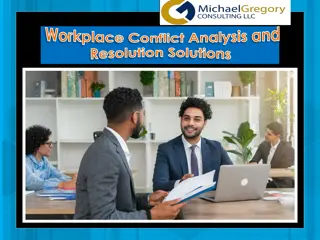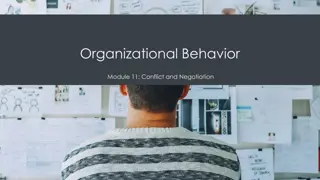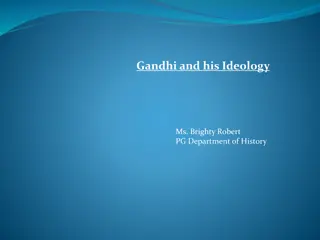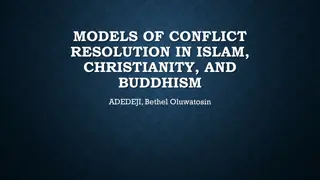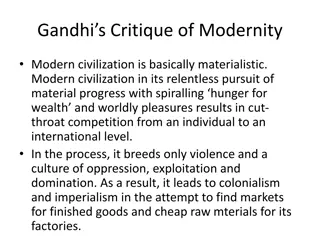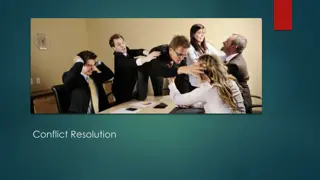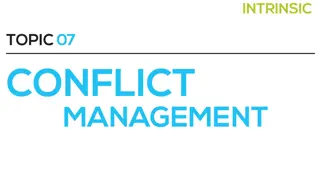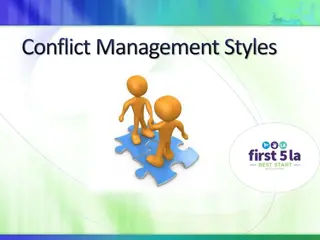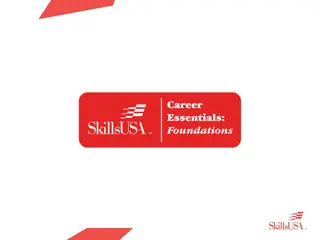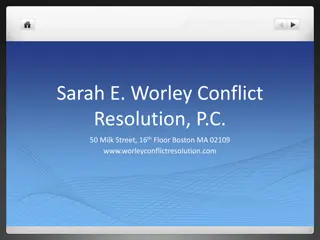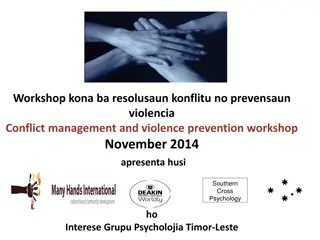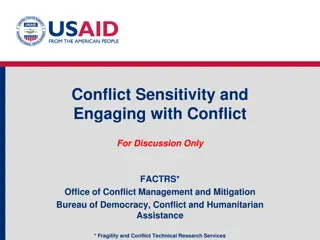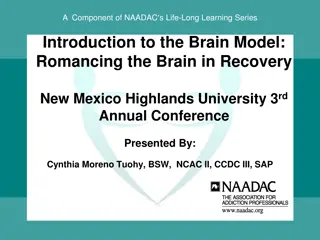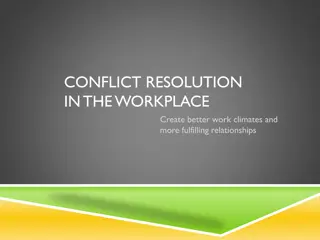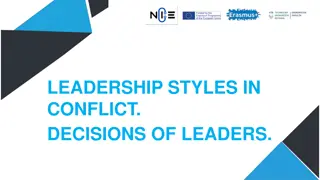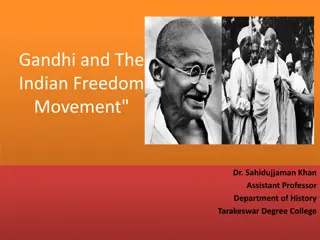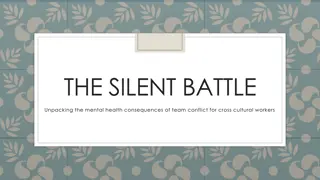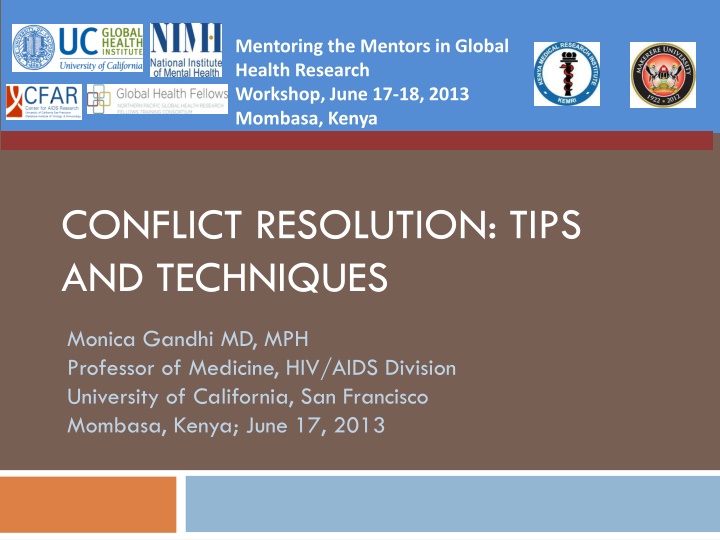
Conflict Resolution Techniques in Global Health Research Workshop
Learn about conflict resolution tips and techniques discussed in the Mentoring the Mentors in Global Health Research Workshop in Mombasa, Kenya. Understand the definition and sources of conflict, why conflict resolution is important, the outcomes of conflict, and ways to resolve conflicts effectively.
Download Presentation

Please find below an Image/Link to download the presentation.
The content on the website is provided AS IS for your information and personal use only. It may not be sold, licensed, or shared on other websites without obtaining consent from the author. If you encounter any issues during the download, it is possible that the publisher has removed the file from their server.
You are allowed to download the files provided on this website for personal or commercial use, subject to the condition that they are used lawfully. All files are the property of their respective owners.
The content on the website is provided AS IS for your information and personal use only. It may not be sold, licensed, or shared on other websites without obtaining consent from the author.
E N D
Presentation Transcript
http://escholarship.ucop.edu/brand/ucghi/ucghi-logo-white-background.pnghttp://escholarship.ucop.edu/brand/ucghi/ucghi-logo-white-background.png Mentoring the Mentors in Global Health Research Workshop, June 17-18, 2013 Mombasa, Kenya CONFLICT RESOLUTION: TIPS AND TECHNIQUES Monica Gandhi MD, MPH Professor of Medicine, HIV/AIDS Division University of California, San Francisco Mombasa, Kenya; June 17, 2013
Definition of the problem Conflict: A condition that exists anytime two or more people disagree Unresolved conflicts may have serious consequences for trainees In U.S., only about 60% of all doctoral students will complete their graduate programs1,2. Reasons for leaving a graduate program include, but are not limited to, conflicts that arise between graduate students and faculty members. Interpersonal conflict is unavoidable, but we can learn to manage it. Bowen and Rudenstine. In Pursuit of the PhD. 1992; Denecke. The Ph.D. Completion Project: Implications for the Study of Master s Degree Attrition. 2005
Sources of Conflict Conflict arises from resource scarcity Goals of parties are incompatible Other structural factors (size, routinization, specialization, reward systems) Conflicting perceptions, ideas, or beliefs Differences between people Conflicting thoughts/needs within an individual Lack of communication
Why address Conflict Resolution? Inevitable in dynamic environments Conflict can lead to feelings of powerlessness Conflict can cause anyone, especially mentees, to view mentors as adversaries Creates conflict and divided loyalties in the workplace
Conflict can result in negative and positive outcomes Negative outcomes of conflict Positive outcomes of conflict Anger Disagreement Hostility Threat Anxiety Competition Tension (Violence, Destruction, Pain, War) Clarity Learning Stimulation Intimacy Courage, Strengthening Creative. Enriching Opportunity Inclusiveness
Just like any mentoring tip, techniques can be taught, patterns broken http://t2.gstatic.com/images?q=tbn:ANd9GcRSMFxeYUdAmG-l6mXiEgbwUHIWL4tLh8i9_fSTs1TuiZ7ZB05LbQ Ways to resolve conflict in a functional, rather than a dysfunctional, manner can be taught We learnt our ways of managing conflict through family, role models, teachers/mentors, players on world stage Turtle (avoidance) http://us.123rf.com/400wm/400/400/anterovium/anterovium1010/anterovium101000119/7945174-cute-teddy-bear-sitting-happy-on-white-background-isolated.jpg Teddy bear (accommodation) http://b50ym1n8ryw31pmkr4671ui1c64.wpengine.netdna-cdn.com/wp-content/blogs.dir/11/files/2012/08/blue-shark.jpg Shark (domination) http://images.nationalgeographic.com/wpf/media-live/photos/000/006/cache/red-fox_679_600x450.jpg Fox (compromise) Barn Owl Owl (integration)
Who owns the problem? The person negatively affected by the problem It is the owner s responsibility to try to resolve the problem, even if she/he is not at fault
So, youve identified a conflict What doesn t work? What does work? Negotiation Mediation Looking at both sides A Win-Win attitude. Yelling Refusing to change or compromise Refusing to work out the conflict, Name calling, walking out, belittling, etc.
Preparing for conflict resolution 93% of the meaning of a message comes from nonverbal sources! Verbal Meaning 7% Facial Expression 55% Tone of Voice 38% Mehrabian, A. (1981) Silent messages: Implicit communication of emotions and attitudes. Belmont, CA: Wadsworth
Preparation Include only those concerned Find a good time and place with no distractions Don t conduct by email! Get something to write down ideas. Give a description of the problem that respects all involved Explain how conflict resolution can enable all to win, and explain the steps Agree not to slip back to the lose-lose, or win-lose methods http://www.siena.edu/uploadedimages/home/news/email-icon.jpg
Strategies for Conflict Resolution Withdrawal little or no significance to either party (lose-lose) Forcing force outcome regardless of the desire of one party (win-lose) Conciliation giving in to preserve relationship with other party (lose-win) Compromise concerned with both outcome and relationship (?-?) CONFRONTATION meet the problem head on (win-win) 1. 2. 3. 4. 5.
The Seven Steps to Effective Conflict Resolution No lose method #1 Identify and clearly define the real problem. #2 Brainstorm solutions. #3 Evaluate the solutions. #4 Choose the best win/win solution. #5 Implement this solution. #6 Choose a follow up date to evaluate. #7 Celebrate your success! Thomas Gordon P.E.T.: Parent Effectiveness Training (1970)
No lose method assumptions Your needs are important My needs are equally important We will approach this conflict from a needs standpoint, not a solution standpoint. I will never use my power.
Step #1: Identify and define the problem Use I Messages to explain your own concerns, needs and basic goals Use reflective listening to hear and acknowledge the other s needs and basic goals Evaluate exactly what each of your actual needs are with the problem. List needs. Don t accept sudden promises not to cause the problem
Step #1 (continued): What in the world is an I message? An I-message or I-statement is an assertion about the feelings, beliefs, values etc. of the person speaking (sentence starts with I ) contrasted with a "you-message (starting with You ) and focuses on ( accuses ) the person spoken to I-messages intend to be assertive, without creating defensiveness Used to take ownership for one's feelings rather than implying that they are caused by another person. Example: "I really am getting backed up on my work since I don't have the financial report yet," rather than: You didn't finish the financial report on time!" Thomas Gordon P.E.T.: Parent Effectiveness Training (1970)
Step #1 (continued): What is reflective or active listening? Look at the person speaking Maintain an open mind Pay attention Ask questions Repeat what the speaker says Listen for the feelings of the speaker Don t: Interrupt, change the subject, make up your mind before the person finishes speaking
Step #1 (cont): What is meant by assertive? Assertive (good) means- Assertive does NOT mean Organized in thought and communication Technically and socially competent Disavowing perfection while looking for clarification / common understanding Being owned by the entire team (this is not just a subordinate skill-set, and it must be valued by the receiver to work) Aggressive Hostile Confrontational Ambiguous Demeaning Condescending
Step #2: Brainstorm solutions Look at things from another s perspective and try to see their point of view Think of any and all possible ways to solve the problem so that everyone will have needs met. Evaluate later NOT NOW Do not criticize any suggestion. Feedback with reflective listening Write down all ideas suggested.
Step #3: Evaluate the possible solutions Ask Will it work? Does it meet all the needs of both people? Are there any problems likely? Don t accept solutions for the sake of speed Use reflective listening and I Messages
Step #4: Choose the best win-win solution Find a solutions that is mutually acceptable to both of you. . If agreement seems difficult, summarize areas of agreement. Restate needs, and look for new solutions. Make certain that both of you are committed to the solution What are win-win solutions? Require more creativity Take more responsibility for helping everyone have needs met Feeling of mutual respect Love grows deeper with every conflict resolved.
Step #5: Implementing the solution (Try it out) Obtain agreement on who does what by when Write this down and check all agree to it Refuse to remind or police the solutions If you want to set criteria for success, work out these now
Step #6: Choose a follow-up date to evaluate Carry out agreed method. Wait to see if the conflicts seems resolved. If the agreed upon solution doesn t work, remember it is the solution that failed, not the person, and seek for a new solution. Ask from time to time if the solution is working for both of you.
Step #7: Celebrate success! After reaching a solution that the two individuals agree will work, they can resume normal activities. http://t3.gstatic.com/images?q=tbn:ANd9GcQdWRGM8lt6qZByU9kFqSae08iyxx7NKSa-N_hqNbO1Cjoy43qm Celebrate!
Questions? http://todaysfreshmanna.files.wordpress.com/2012/12/mentor.jpg?w=400h=400 http://t1.gstatic.com/images?q=tbn:ANd9GcQx_KtjWouzj7FXzFPJiJ4wEXmz21x8XnTJWha-D1dB-_3gthJ1


